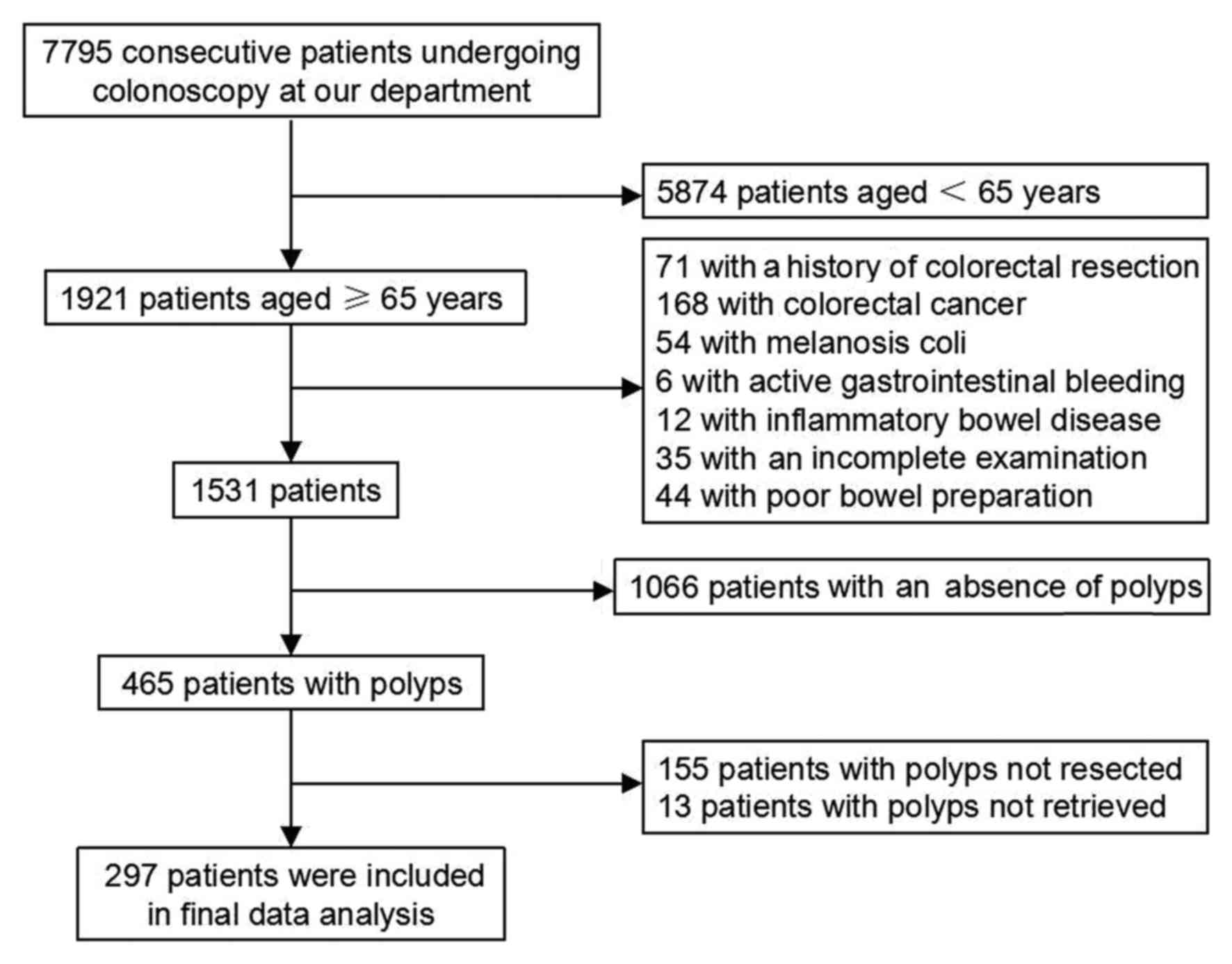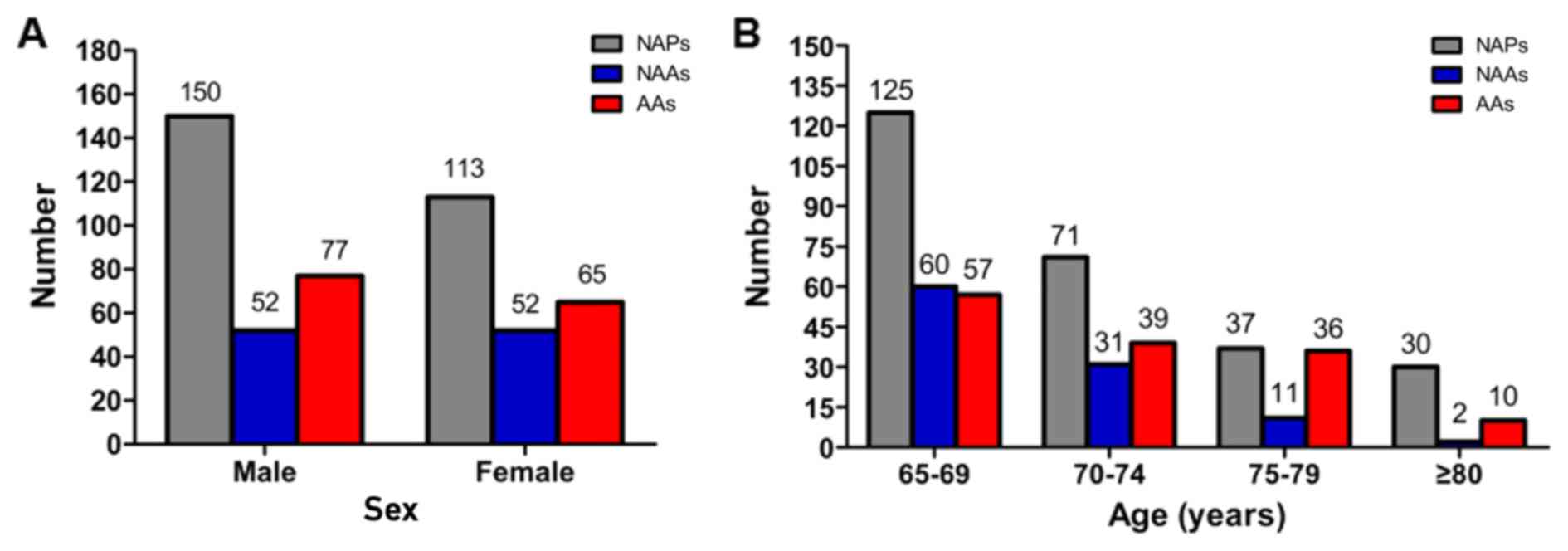|
1
|
World Health Organization International
Agency for Research on Cancer, . GLOBOCAN 2012: Estimated Cancer
Incidence, Mortality and Prevalence Worldwide in 2012. http://www-dep.iarc.fr/August 10–2014
|
|
2
|
Yazdizadeh B, Jarrahi AM, Mortazavi H,
Mohagheghi MA, Tahmasebi S and Nahvijo A: Time trends in the
occurrence of major GI cancers in Iran. Asian Pac J Cancer Prev.
6:130–134. 2005.PubMed/NCBI
|
|
3
|
Khuhaprema T and Srivatanakul P: Colon and
rectum cancer in Thailand: An overview. Jpn J Clin Oncol.
38:237–243. 2008. View Article : Google Scholar : PubMed/NCBI
|
|
4
|
Dai Z, Zheng RS, Zou XN, Zhang SW, Zeng
HM, Li N and Chen WQ: Analysis and prediction of colorectal cancer
incidence trend in China. Zhonghua Yu Fang Yi Xue Za Zhi.
46:598–603. 2012.(In Chinese). PubMed/NCBI
|
|
5
|
Leslie A, Carey FA, Pratt NR and Steele
RJ: The colorectal adenoma-carcinoma sequence. Br J Surg.
89:845–860. 2002. View Article : Google Scholar : PubMed/NCBI
|
|
6
|
Neugut AI, Jacobson JS and De Vivo I:
Epidemiology of colorectal adenomatous polyps. Cancer Epidemiol
Biomarkers Prev. 2:159–176. 1993.PubMed/NCBI
|
|
7
|
Heitman SJ, Ronksley PE, Hilsden RJ, Manns
BJ, Rostom A and Hemmelgarn BR: Prevalence of adenomas and
colorectal cancer in average risk individuals: A systematic review
and meta-analysis. Clin Gastroenterol Hepatol. 7:1272–1278. 2009.
View Article : Google Scholar : PubMed/NCBI
|
|
8
|
Strul H, Kariv R, Leshno M, Halak A,
Jakubowicz M, Santo M, Umansky M, Shirin H, Degani Y, Revivo M, et
al: The prevalence rate and anatomic location of colorectal adenoma
and cancer detected by colonoscopy in average-risk individuals aged
40–80 years. Am J Gastroenterol. 101:255–262. 2006. View Article : Google Scholar : PubMed/NCBI
|
|
9
|
Short MW, Layton MC, Teer BN and
Domagalski JE: Colorectal cancer screening and surveillance. Am Fam
Physician. 91:93–100. 2015.PubMed/NCBI
|
|
10
|
Aronchick CA, Lipshutz WH, Wright SH,
Dufrayne F and Bergman G: A novel tableted purgative for
colonoscopic preparation: Efficacy and safety comparisons with
colyte and fleet phospho-soda. Gastrointest Endosc. 52:346–352.
2000. View Article : Google Scholar : PubMed/NCBI
|
|
11
|
Hong SN, Kim JH, Choe WH, Han HS, Sung IK,
Park HS and Shim CS: The prevalence and risk of colorectal neoplasm
in asymptomatic average-risk screenees aged 40 to 49 years of age.
Gastrointest Endosc. 72:480–489. 2010. View Article : Google Scholar : PubMed/NCBI
|
|
12
|
The Paris endoscopic classification of
superficial neoplastic lesions: Esophagus, stomach, and colon:
November 30 to December 1, 2002. Gastrointest Endosc. 58 6
Suppl:S3–S43. 2003. View Article : Google Scholar : PubMed/NCBI
|
|
13
|
Fong TV, Chuah SK, Chiou SS, Chiu KW, Hsu
CC, Chiu YC, Wu KL, Chou YP, Ong GY and Changchien CS: Correlation
of the morphology and size of colonic polyps with their histology.
Chang Gung Med J. 26:339–343. 2003.PubMed/NCBI
|
|
14
|
Pullens HJ, Joosten M, Siersema PD and
Brink MA: Open-access flexible sigmoidoscopy frequently leads to
additional colonoscopy in symptomatic patients over 50 years. J
Gastrointestin Liver Dis. 23:153–159. 2014. View Article : Google Scholar : PubMed/NCBI
|
|
15
|
Yang MH, Rampal S, Sung J, Choi YH, Son
HJ, Lee JH, Kim YH, Chang DK, Rhee PL, Rhee JC, et al: The
prevalence of colorectal adenomas in asymptomatic Korean men and
women. Cancer Epidemiol Biomarkers Prev. 23:499–507. 2014.
View Article : Google Scholar : PubMed/NCBI
|
|
16
|
de Oliveira AM, Anapaz V, Lourenço L,
Graça Rodrigues C, Alberto S Folgado, Martins A, de Deus J Ramos
and Reis J: Is there a proximal shift in the distribution of
colorectal adenomas? United European Gastroenterol J. 3:353–357.
2015. View Article : Google Scholar : PubMed/NCBI
|
|
17
|
Yamaji Y, Mitsushima T, Ikuma H, Watabe H,
Okamoto M, Kawabe T, Wada R, Doi H and Omata M: Incidence and
recurrence rates of colorectal adenomas estimated by annually
repeated colonoscopies on asymptomatic Japanese. Gut. 53:568–572.
2004. View Article : Google Scholar : PubMed/NCBI
|
|
18
|
Patel K and Hoffman NE: The anatomical
distribution of colorectal polyps at colonoscopy. J Clin
Gastroenterol. 33:222–225. 2001. View Article : Google Scholar : PubMed/NCBI
|
|
19
|
Zare-Mirzaie A, Abolhasani M and
Aryamanesh A: Left sided colorectal adenomatous polyps have more
risk for high grade dysplasia. Acta Med Iran. 51:172–177.
2013.PubMed/NCBI
|
|
20
|
Levin B, Lieberman DA, McFarland B, Smith
RA, Brooks D, Andrews KS, Dash C, Giardiello FM, Glick S, Levin TR,
et al: Screening and surveillance for the early detection of
colorectal cancer and adenomatous polyps, 2008: A joint guideline
from the American cancer society, the US multi-society task force
on colorectal cancer, and the american college of radiology. CA
Cancer J Clin. 58:130–160. 2008. View Article : Google Scholar : PubMed/NCBI
|
|
21
|
Day LW and Velayos F: Colorectal cancer
screening and surveillance in the elderly: Updates and
controversies. Gut Liver. 9:143–151. 2015. View Article : Google Scholar : PubMed/NCBI
|
|
22
|
Trecca A, Gaj F, Di Lorenzo GP, Ricciardi
MR, Silano M, Bella A and Sperone M: Improved detection of
colorectal neoplasms with selective use of chromoendoscopy in 2005
consecutive patients. Tech Coloproctol. 10:339–344. 2006.
View Article : Google Scholar : PubMed/NCBI
|
|
23
|
Park SY, Lee SK, Kim BC, Han J, Kim JH,
Cheon JH, Kim TI and Kim WH: Efficacy of chromoendoscopy with
indigocarmine for the detection of ascending colon and cecum
lesions. Scand J Gastroenterol. 43:878–885. 2008. View Article : Google Scholar : PubMed/NCBI
|
|
24
|
Testoni PA, Notaristefano C, Vailati C, Di
Leo M and Viale E: High-definition colonoscopy with i-Scan: Better
diagnosis for small polyps and flat adenomas. World J
Gastroenterol. 18:5231–5239. 2012.PubMed/NCBI
|
|
25
|
Chiu HM, Chang LC, Shun CT, Wu MS and Wang
HP: Current management of diminutive colorectal polyps in Taiwan.
Dig Endosc. 26 Suppl 2:S64–S67. 2014. View Article : Google Scholar
|
|
26
|
Matsuda T, Kawano H, Hisabe T, Ikematsu H,
Kobayashi N, Mizuno K, Oka S, Takeuchi Y, Tamai N, Uraoka T, et al:
Current status and future perspectives of endoscopic diagnosis and
treatment of diminutive colorectal polyps. Dig Endosc. 26 Suppl
2:S104–S108. 2014. View Article : Google Scholar
|
|
27
|
Chaput U, Alberto SF, Terris B, Beuvon F,
Audureau E, Coriat R, Roche H, Gaudric M, Prat F and Chaussade S:
Risk factors for advanced adenomas amongst small and diminutive
colorectal polyps: A prospective monocenter study. Dig Liver Dis.
43:609–612. 2011. View Article : Google Scholar : PubMed/NCBI
|
|
28
|
Shapiro R, Ben-Horin S, Bar-Meir S and
Avidan B: The risk of advanced histology in small-sized colonic
polyps: Are non-invasive colonic imaging modalities good enough?
Int J Colorectal Dis. 27:1071–1075. 2012. View Article : Google Scholar : PubMed/NCBI
|
|
29
|
Hassan C, Pickhardt PJ, Kim DH, Di Giulio
E, Zullo A, Laghi A, Repici A, Iafrate F, Osborn J and Annibale B:
Systematic review: Distribution of advanced neoplasia according to
polyp size at screening colonoscopy. Aliment Pharmacol Ther.
31:210–217. 2010.PubMed/NCBI
|
|
30
|
Tsai FC and Strum WB: Prevalence of
advanced adenomas in small and diminutive colon polyps using direct
measurement of size. Dig Dis Sci. 56:2384–2388. 2011. View Article : Google Scholar : PubMed/NCBI
|
|
31
|
Lieberman DA, Rex DK, Winawer SJ,
Giardiello FM, Johnson DA and Levin TR; United States Multi-Society
Task Force on Colorectal Cancer, : Guidelines for colonoscopy
surveillance after screening and polypectomy: A consensus update by
the US multi-society task force on colorectal cancer.
Gastroenterology. 143:844–857. 2012. View Article : Google Scholar : PubMed/NCBI
|
|
32
|
Hassan C, Repici A, Zullo A and Sharma P:
New paradigms for colonoscopic management of diminutive colorectal
polyps: Predict, resect, and discard or do not resect? Clin Endosc.
46:130–137. 2013. View Article : Google Scholar : PubMed/NCBI
|
|
33
|
Ignjatovic A, East JE, Suzuki N, Vance M,
Guenther T and Saunders BP: Optical diagnosis of small colorectal
polyps at routine colonoscopy (Detect InSpect ChAracterise Resect
and Discard; DISCARD trial): A prospective cohort study. Lancet
Oncol. 10:1171–1178. 2009. View Article : Google Scholar : PubMed/NCBI
|
|
34
|
Hassan C, Pickhardt PJ and Rex DK: A
resect and discard strategy would improve cost-effectiveness of
colorectal cancer screening. Clin Gastroenterol Hepatol. 8:865–869.
2010. View Article : Google Scholar : PubMed/NCBI
|
|
35
|
McGill SK, Evangelou E, Ioannidis JP,
Soetikno RM and Kaltenbach T: Narrow band imaging to differentiate
neoplastic and non-neoplastic colorectal polyps in real time: A
meta analysis of diagnostic operating characteristics. Gut.
62:1704–1713. 2013. View Article : Google Scholar : PubMed/NCBI
|
|
36
|
Takeuchi Y, Hanafusa M, Kanzaki H, Ohta T
and Hanaoka N: Proposal of a new ‘resect and discard’ strategy
using magnifying narrow band imaging: Pilot study of diagnostic
accuracy. Dig Endosc. 26 Suppl 2:S90–S97. 2014. View Article : Google Scholar
|
|
37
|
Endoscopic Diagnosis and Treatment Group
of Early Digestive Cancer, Chinese Society of Digestive Endoscopy;
Gastrointestinal tumor group, Chinese Society of Gastroenterology
and Intestinal Study group, Chinese Society of Digestive Endoscopy,
. Chinese consensus: screening, diagnosis and treatment of early
colorectal cancer and precancerous lesions (2014, Chongqing). Chin
J Dig Endosc. 2:69–85. 2015.(In Chinese).
|













